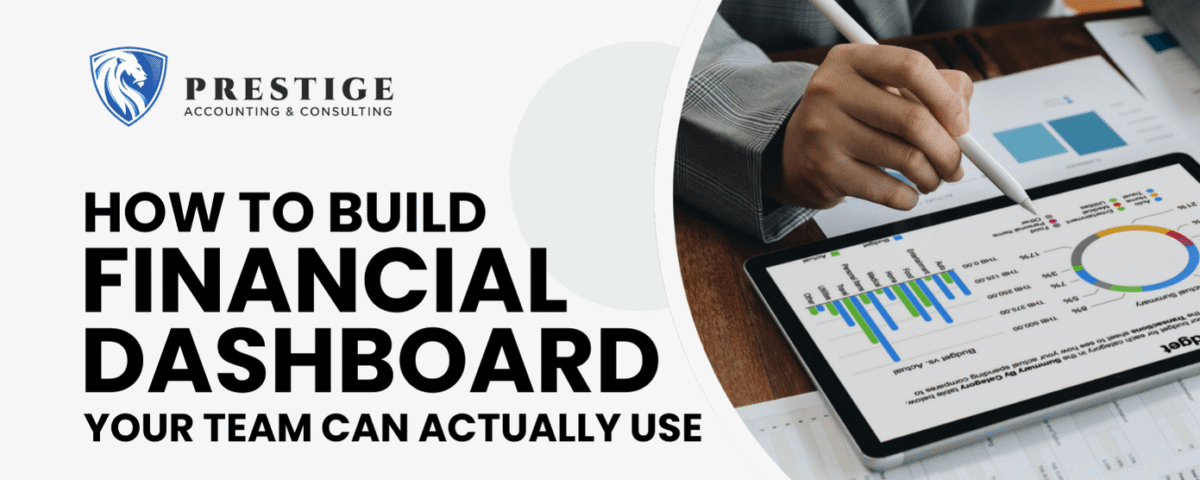
Are You Charging Enough? Signs Your Pricing Needs a Strategy
August 12, 2025
Top KPIs Every Law Firm Should Track (But Most Don’t)
August 19, 2025
Categories
How to Build a Financial Dashboard Your Team Can Actually Use
When your law firm is small, manually tracking income and expenses might work. But as your practice grows, so does your need for clarity, speed, and insight.
That’s where a financial dashboard comes in.
A dashboard is more than a chart or summary—it’s a central command center for your business. And if you build it right, it helps your team make smarter decisions, spot problems before they escalate, and stay focused on what actually drives profit.
Why Most Law Firms Don’t Use Dashboards (and Why They Should)
Most attorneys don’t set up dashboards because:
- They don’t know where to start
- They think it’s “too advanced” or “only for big firms”
- Their books are behind, so they’re afraid of what they’ll see
- They’re stuck in spreadsheet mode—and overwhelmed
But here’s the reality:
If you can open a Google Sheet or look at a Clio report, you can use a dashboard.
The right one can save you from:
- Missed billing targets
- Overstaffing during slow months
- Undetected scope creep
- Blind marketing spend
- Cash flow surprises
What a Financial Dashboard Should Actually Show
A good dashboard isn’t cluttered. It’s not a spreadsheet full of rows no one checks. It focuses on decision-ready numbers, like:
 Revenue
Revenue- Monthly revenue vs. goal
- Revenue by practice area
- Billed vs. collected
 Profitability
Profitability- Net profit margin (monthly and YTD)
- Owner compensation vs. plan
- Fixed vs. variable costs
 Cash Flow
Cash Flow- Cash on hand
- Upcoming expenses
- Estimated tax liabilities
 Trust Compliance (if applicable)
Trust Compliance (if applicable)- Trust balance
- Earned vs. unearned income
- Three-way reconciliation status
 Productivity Metrics
Productivity Metrics- Billable hours per attorney
- Case volume by stage
- Intake conversion rates
If your dashboard doesn’t show what’s happening right now, it’s not a dashboard—it’s a lagging report.
How to Build a Simple Dashboard (Even If You’re Not a Numbers Person)
You don’t need a fancy system to start. Here’s a progression based on your firm’s stage:
Stage 1: Spreadsheet-Based Dashboard
If your books are in QuickBooks but you’re not using reporting software, start with a monthly spreadsheet that includes:
- Monthly revenue and expenses
- Profit margin
- Cash balance
- Total receivables and payables
- Trust balance (if applicable)
Tools: Google Sheets + Data from QuickBooks
Stage 2: Accounting Dashboard Tools
As you grow, plug your accounting software into dashboard apps like:
- Fathom
- LivePlan
- Syft Analytics
- QuickBooks Advanced Dashboard
These tools let you see trends, track goals, and generate easy-to-share visuals for your team.
Stage 3: Integrated Firm Dashboard
Use practice management software (like Clio, Lawmatics, or PracticePanther) alongside your financial tools to get a 360° view:
- Matter pipeline + revenue forecasting
- Team workload + capacity planning
- Real-time KPI tracking
This is where your COO, marketing lead, or paralegal manager can use data to drive weekly decisions—without waiting on your bookkeeper to generate reports.
Why Your Team Needs Access Too
Too many lawyers hoard the numbers. But your team can’t help you grow what they can’t see.
Giving your staff dashboard access (with the right permissions) helps:
- Admins manage receivables and collections proactively
- Associates stay aware of billing targets
- Intake teams measure conversions
- Managers forecast hiring and support needs
A great dashboard empowers your people to act—without you being the bottleneck.
How We Help Law Firms Build Dashboards That Work
At Prestige Accounting and Consulting, we don’t just reconcile your books. We help law firm owners:
- Identify the metrics that actually matter
- Spot weak points in revenue, profit, or operations
- Translate your data into decisions that grow the firm
 Book your free consultation and we’ll review what you’re currently tracking—and what’s missing from your decision-making system.
Book your free consultation and we’ll review what you’re currently tracking—and what’s missing from your decision-making system.Because when you see the right numbers in real time, your entire firm runs smarter.




